The Apple II was launched in 1977, a full 47 years ago. The Apple IIe came out six years later, with a higher level of integration and a raft of new useful features. Apple eventually ended production of the whole Apple II line in 1993, but that wasn’t the end. People like [James Lewis] are still riffing on the platform to this day. Even better, he came to Supercon 2023 to tell us all about his efforts!
[James]’s talk covers the construction of the Mega IIe, a portable machine of his own design. As the name suggests, the project was based on the Mega II chip, an ASIC for which he had little documentation. He wasn’t about to let a little detail like that stop him, though.
The journey of building the Mega IIe wasn’t supposed to be long or arduous; the initial plan was to “just wire this chip up” as [James] puts it. Things are rarely so simple, but he persevered nonetheless—and learned all about the Apple II architecture along the way.
Simply Mega
For the unfamiliar, the Mega II contained most of Apple IIe, but condensed down to fit on to one single 84-pin ASIC. It first appeared in 1986, and was used in the Apple IIGS. The Mega II chip doesn’t contain a CPU, but does contain a lot of the supporting hardware that makes the Apple IIe what it is. The IOU, MMU, video and keyboard ROMs, and keyboard and mouse controller are all there.
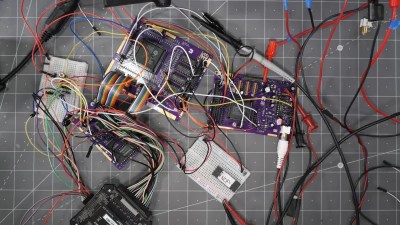
[James]’s talk starts by dispelling some myths. The first is that the Mega II is a single-chip Apple II. His own build makes it obvious that’s not the case. Beyond that, he also notes that the Apple IIGS didn’t use the Mega II for backwards compatibility. It was instead used as a memory controller and for working with classic Apple II video modes and the expansion slots. He also states that the “Gemini” chip from the Macintosh LC Apple II card is not a Mega II, based on significant differences in registers and general design. He wanted to check on a rumor, too, that the chip was never finished, hence why it was just used as a basic controller in the Apple IIGS. To figure that out, he wanted to prove that you could build a functional Apple II using the Mega II chip salvaged from the IIGS.
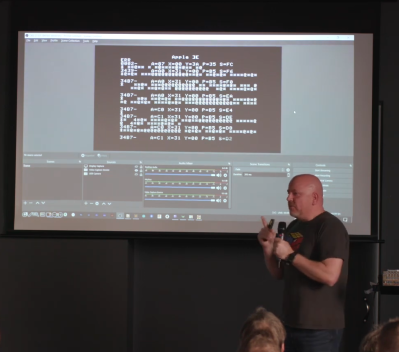
Early work went well. After spinning up a basic board with the Mega II and the necessary hardware, [James] was able to get a text video mode working. It spat out a lot of gibberish, but it was evidence that something was going on. The string “Apple ][” even appeared in the output!
It wasn’t smooth sailing from there, though. Months of debugging ensued, with a logic analyzer showing the “computer” he’d built was making seemingly random jumps all over the place rather than going through a normal boot process. He suspected it was because the chip wasn’t finished, but that wasn’t the case. Eventually, a friend suggested he check if one of the data bus lines was stuck. It turned out a stuck wire fragment on a solder pad was causing all of his problems. With that fixed, he made a huge leap forward. He saw the message appear—”KERNEL OK”. Success!
However, he still wasn’t at a prompt. He was stuck in a test routine, and didn’t have a fully fledged computer. Nonetheless, he knew this meant he was on the right path. If the test routine was behaving appropriately, it suggested the Mega II really did have most of an Apple II living inside it.
From there, the talk goes through the arduous work required to get this thing fully operational. He faced crash after crash as he tried to get a full boot to happen. Once he got that far, he had to try and go from a rat’s nest of wires and breadboards to something that wouldn’t fall apart every time he breathed on it. His final design has some neat features—like the way he built his own motherboard with a connector that let him plug his logic analyzer right in with a single connector.
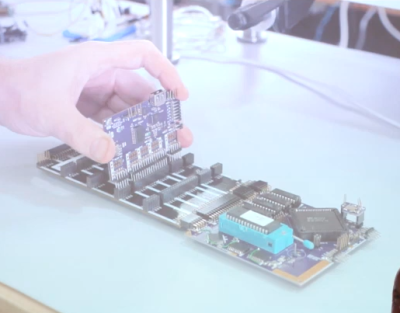
By revision 2, he had the thing built up on a bunch of PCBs with header connectors, and it was even booting from floppy disks. The amount of work it took to get even this far was phenomenal. [James] didn’t just have to whip up a motherboard, he had to do all kinds of work to give the thing a working keyboard interface and the ability to read floppy disks. By this point, he’d realized that the supposed single chip solution that was the Mega II anything but. Beyond RAM, ROM, and a CPU, it also needed another custom ASIC called SlotMaker, and a keyboard controller. This chip is for handling expansion slots, but it also handles one important signal for the keyboard that makes it essential to the computer’s proper functioning. Frustrating stuff indeed. Other work involved producing video output over VGA and creating a working sound board.
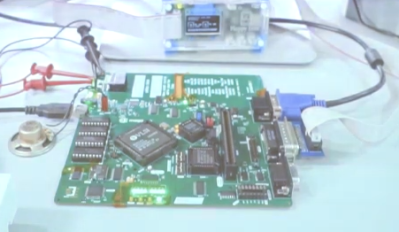
His third revision involved consolidating his multi-PCB solution into a working computer on a single PCB. A few mistakes cropped up in the board design, but it wasn’t enough to stop [James]. With a little creative bodging, he got the thing operational. He’d managed to build a working computer based around the Mega II ASIC.
He may not have been the first to build a Mega II into a working computer; [James] admits that the prototype of the Tiger Learning Computer from Tiger Electronics does serve as an existing example that the Mega II was usable as a fully-fledged machine. But he did manage to do it without any support or documentation from Apple at all. That’s no mean feat.
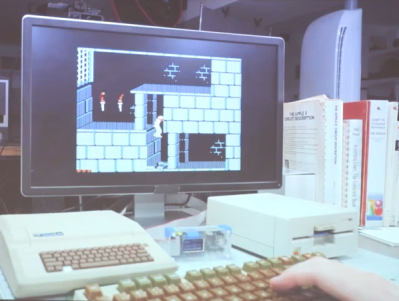
Watching the talk, it’s easy to understand why the project took [James] several years to complete. It’s always neat to see someone set themself a difficult goal and follow through to completion. It’s also rad that [James] was able to teach us so much more about the Mega II that we never knew before. That’s worthy of celebration!
















One of the best programs written for the //e was a program called Diversi-Dial.
It was a 7 line chat system. 7 300 SSM Modemcards , or Micromodem ][e or AppleCat modems, and you had a system where users could hang out, chat and have a good time. A recreation of this system is located at http://www.ddial.com and several systems
including an original STS are linked together. You can also access it via the web at http://www.magviz.ca I am usually on there as are many who remember the dial-up era.
Bill Basham (RIP) was quite the programmer and to get a 1 mhz machine to do what it did was amazing for the time. Passwords on Magviz and all linked systems are free.
DDial itself was known as the ‘anti-social’ network. At its peak there were 80 systems spread around the USA and Canada. At times, there were 20-30 systems linked together. As one girl I knew from back then once said, “It was the height of Reganomics and we partied like animals.” Drop in, say hi, and if you’re a ham operator, we have a few members that are too.
I am a IIe enthusiast and 6502 programmer. I have recently completed my own rather difficult project of creating a version of the game Breakout called Jakeout. My version is written entirely in assembly and I have posted the source code along with the disk image for people to play around with. Check out this video for more info. https://youtu.be/GaYudpCUrPE?si=2E3y5f1IT9JKJmWc
Is there such a thing as new-old-stock of Mega II chips or are IIGS’s the only source?